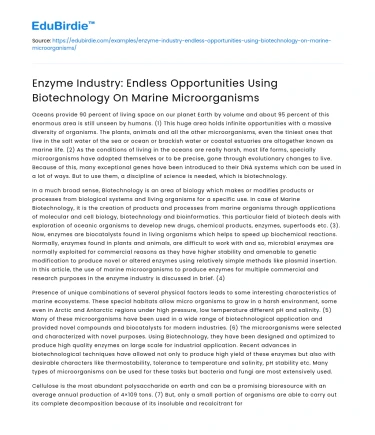Oceans provide 90 percent of living space on our planet Earth by volume and about 95 percent of this enormous area is still unseen by humans. (1) This huge area holds infinite opportunities with a massive diversity of organisms. The plants, animals and all the other microorganisms, even the tiniest ones that live in the salt water of the sea or ocean or brackish water or coastal estuaries are altogether known as marine life. (2) As the conditions of living in the oceans are really harsh, most life forms, specially microorganisms have adopted themselves or to be precise, gone through evolutionary changes to live. Because of this, many exceptional genes have been introduced to their DNA systems which can be used in a lot of ways. But to use them, a discipline of science is needed, which is biotechnology.
In a much broad sense, Biotechnology is an area of biology which makes or modifies products or processes from biological systems and living organisms for a specific use. In case of Marine Biotechnology, it is the creation of products and processes from marine organisms through applications of molecular and cell biology, biotechnology and bioinformatics. This particular field of biotech deals with exploration of oceanic organisms to develop new drugs, chemical products, enzymes, superfoods etc. (3). Now, enzymes are biocatalysts found in living organisms which helps to speed up biochemical reactions. Normally, enzymes found in plants and animals, are difficult to work with and so, microbial enzymes are normally exploited for commercial reasons as they have higher stability and amenable to genetic modification to produce novel or altered enzymes using relatively simple methods like plasmid insertion. In this article, the use of marine microorganisms to produce enzymes for multiple commercial and research purposes in the enzyme industry is discussed in brief. (4)
Save your time!
We can take care of your essay
- Proper editing and formatting
- Free revision, title page, and bibliography
- Flexible prices and money-back guarantee
Presence of unique combinations of several physical factors leads to some interesting characteristics of marine ecosystems. These special habitats allow micro organisms to grow in a harsh environment, some even in Arctic and Antarctic regions under high pressure, low temperature different pH and salinity. (5) Many of these microorganisms have been used in a wide range of biotechnological application and provided novel compounds and biocatalysts for modern industries. (6) The microorganisms were selected and characterized with novel purposes. Using Biotechnology, they have been designed and optimized to produce high quality enzymes on large scale for industrial application. Recent advances in biotechnological techniques have allowed not only to produce high yield of these enzymes but also with desirable characters like thermostability, tolerance to temperature and salinity, pH stability etc. Many types of microorganisms can be used for these tasks but bacteria and fungi are most extensively used.
Cellulose is the most abundant polysaccharide on earth and can be a promising bioresource with an average annual production of 4×109 tons. (7) But, only a small portion of organisms are able to carry out its complete decomposition because of its insoluble and recalcitrant form and crystalline microfibril structure. (8) An intriguing discovery in this area is purification and characterization of a new salt tolerant and thermostable cellulase named Bc22Cel from a marine Baciillus sp. SR22 strain by Dos Santos et al. The enzyme showed an optimal pH value of 6.5 and optimum temperature of 60℃. It also showed considerably high amount of halophilic property by being able to maintain 70 percent of residual activity even when incubated with 1.5M NaCl for 1 hour. The kinetic analysis showed that the Km and Vmax of 0.704 mg/ml and 29.85 µmol·ml-1·min-1 for the purified enzyme. The enzyme showed a broad pH and temperature range and incredible salt tolerance. Sugarcane bagasse was used to evaluate activity of the bacteria to use this enzyme. (9)
This work clearly indicates that a marine bacterium which naturally contains this enzyme, could show endless capabilities. If the gene for the enzyme can be properly isolated and optimized, this can lead to potential industrial level biofuel production. More research on this strain and this new enzyme needs to be done for proper optimization of the gene for this enzyme to get the highest possible cellulase activity out of it. If this can be done industrially, it can lead to good amount of biofuel production and achieve sustainable energy solution. So, in short, the possibilities are endless for this.






 Stuck on your essay?
Stuck on your essay?

